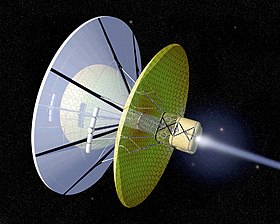
Back محرك بوسارد النفاث Arabic Bussardkollektor German Estatorreactor Bussard Spanish رمجت بوسارد Persian Collecteur Bussard French מגח בוסארד HE Collettore di Bussard Italian バザード・ラムジェット Japanese ബുസാർഡ് റാംജെറ്റ് Malayalam Bussard-collector Dutch


- Interstellar medium
- Collect and compress hydrogen
- Transport hydrogen beside the payload
- Thermonuclear fusion
- Engine nozzle
- Flue gas jet
The Bussard ramjet is a theoretical method of spacecraft propulsion for interstellar travel. A fast moving spacecraft scoops up hydrogen from the interstellar medium using an enormous funnel-shaped magnetic field (ranging from kilometers to many thousands of kilometers in diameter); the hydrogen is compressed until thermonuclear fusion occurs, which provides thrust to counter the drag created by the funnel and energy to power the magnetic field. The Bussard ramjet can thus be seen as a ramjet variant of a fusion rocket.[citation needed]
The Bussard ramjet was proposed in 1960 by the physicist Robert W. Bussard.[1]
The concept was popularized by Poul Anderson in his novel Tau Zero, Larry Niven in his Known Space series of books, Vernor Vinge in his Zones of Thought series, and Carl Sagan, as referenced in the television series and book Cosmos.[citation needed]
- ^ Bussard, Robert W. (1960). Galactic Matter and Interstellar Flight (PDF). Astronautica Acta. Vol. 6. pp. 179–195. Archived from the original (PDF) on 2018-04-17. Retrieved 2014-10-04.
© MMXXIII Rich X Search. We shall prevail. All rights reserved. Rich X Search